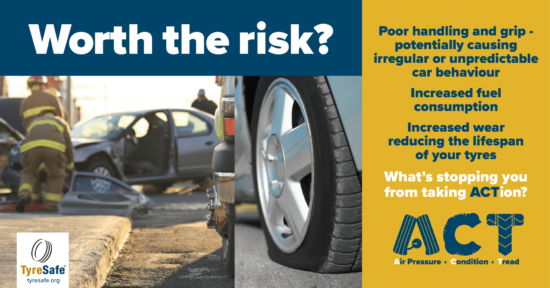TyreSafe launches spring safety campaign – ‘Do you drive and hope?’
 TyreSafe’s spring message challenges drivers not to take unnecessary risks with tyre safety
TyreSafe’s spring message challenges drivers not to take unnecessary risks with tyre safety
TyreSafe wants to encourage drivers to make more frequent checks on their tyres ahead of a busy period for UK highways
TyreSafe has launched its spring tyre safety message, asking drivers, “Do you drive and hope?” The road safety charity wants to spread its message, supported by its ACT acronym, that drivers should check their tyres’ air pressure, condition and tread on a regular basis. Spring is a particularly good time to get this message out, with unpredictable driving conditions due to inclement weather, more heavily laden cars as families travel over the long bank holiday weekends (of which there is one more in 2023 thanks to the coronation of King Charles III), and busier roads.
Stuart Lovatt, TyreSafe chair, said: “This spring is likely to see record breaking numbers of vehicles taking to the roads to make the most of the additional bank holiday. It’s a wonderful time of year as many people take the extra leave from work to spend time with loved ones and explore. The last thing drivers want is an unnecessary interruption to their journey, or at worst a catastrophe, which can be so easily avoided by performing simple checks. It only takes a few minutes and could be the difference between a cracking long weekender and a bank holiday nightmare.”
An additional bank holiday weekend for the King’s coronation joins the regular Easter break and May bank holiday. These dates typically see a sharp rise in weekend breaks, typically involving more heavily laden vehicles as families travel together. With the weather set to remain unpredictable, TyreSafe is asking drivers to not take a chance on their tyre safety by performing regular checks every month and before long journeys.
TyreSafe is also urging all motorists to ensure they have adequate breakdown cover, recommending that motorists do not attempt to repair or replace a tyre on the side of the road, and instead call for assistance.
TyreSafe provides a wealth of resources, guidance and instructional videos to further assist drivers in performing checks on their tyres at home. These can be found at www.tyresafe.org/checks and on TyreSafe’s YouTube channel. They also supply their members and supporters with a suite of assets to share with their customers to help further spread the tyre safety message.
Those wishing to support this year’s campaigns will find a range of assets under the ‘For supporters’ section of tyresafe.org. Materials will include videos and images to be used on social media. Official TyreSafe supporters can access further assets, including customisable print-ready files, via the members’ area. To access this, supporters are asked to complete a registration form which theteam@tyresafe.org will approve. Then they simply use their login details to be able to download the materials, which can be customised with their organisation’s logo.

To help drivers remember the three vital checks, TyreSafe uses the acronym ACT – air pressure, condition and tread.
Air pressure: The air pressure of each tyre should also be checked using an accurate gauge. Typically, car manufacturers recommend two different tyre pressures, one for light loads and another for when the vehicle is fully. It’s essential that drivers adjust the pressures to accommodate the load they are carrying. These settings can be found in the vehicle handbook, on reputable internet tyre pressure charts such as the one at tyresafe.org, and often in the vehicle’s fuel filler cap or door sill.
Condition: With a visual check, looking at the overall condition of each tyre to see if anything might have penetrated the tread, such as nails or other objects. If any of these objects, cracks or bulges are present, the driver should refer immediately seek professional advice.
Tread: Drivers should check the tread of their tyres to ensure they are above the UK the legal tread depth minimum of 1.6mm. Ideally an accurate tread depth gauge should be used but if this is not available, a 20p coin can be used as a guide. Insert the 20p into the main sections of the tyre and at various points around the circumference – should you see the outer rim at any point, you need to have the tread depth checked as it may be illegal.



Comments